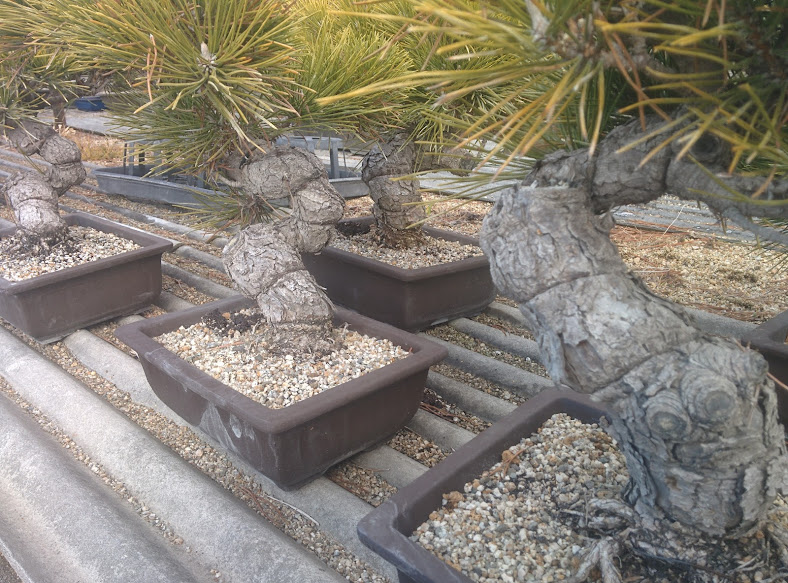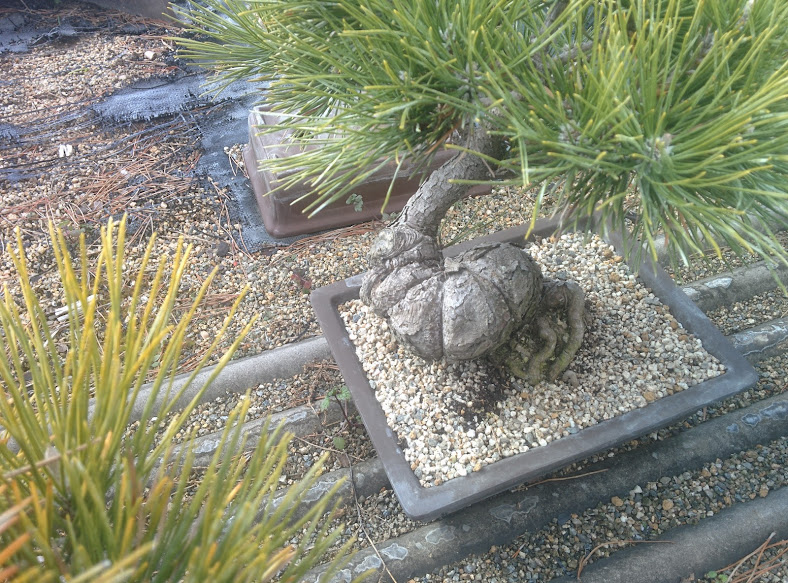Page 1 of 3
Twisted mini JBP - how to avoid reverse taper
Posted: March 10th, 2015, 9:39 am
by squizzy
Just thought I might update my progress on a few of these seedlings to see how far they have come over the past summer.
So for the past 5 months these have had the wire left on and have started to produce some fairly cool trunks. One thing I am having issue with is that the swelling isn't going all the way to the roots on some of the trees which is an issue. I would love to know how others combat this or whether it is something fixable in the future maybe through ground layering?
Will be good to see what I get out of this batch in the future.
Squizz
Will load some photos via tapatalk.
Re: you just need to look
Posted: March 10th, 2015, 9:47 am
by squizzy

one of the better ones with good taper

fat trunk but really bad reverse taper


about 70 or so to work on
Re: you just need to look
Posted: March 10th, 2015, 10:37 am
by Scott Roxburgh
The swelling is something that I too have observed, and haven't yet seen any fix so I no longer leave the wire in. Maybe if you grow the trunk out beyond shohin the effect will be limited, or the roots will pull the base out?
Re: you just need to look
Posted: March 10th, 2015, 11:30 am
by BirchMan
That's an awesome haul, just what I want in 5 years' time.
Re: you just need to look
Posted: March 10th, 2015, 12:23 pm
by Steven
Looking nice Squizzy! You'll have some excellent stock in a few years.
I have no answers but I can confirm that mine are doing the same thing...
2015 March (1).JPG
2015 March (2).JPG
2015 March (3).JPG
Re: you just need to look
Posted: March 10th, 2015, 12:35 pm
by JaseH
Re: you just need to look
Posted: March 10th, 2015, 1:29 pm
by MoGanic
Looks like the reverse taper is because all the dramatic bends are swelling - but the very base of the tree has not really been bent.
Another issue could be the wire may not have been tight enough at the base.
Possible solution - wire only the base for 1 or so years to give it a head start, do the rest once this initial wire is biting in.
Anyone have any other experiences with this technique? I remember Antall having a couple of these going but he hasn't been active for a long time.
Cheers,
Mo
Sent from my iPhone using Tapatalk
Re: you just need to look
Posted: March 10th, 2015, 1:36 pm
by squizzy
Well firstly. I think this needs a thread of its own as there seems to be many of us interested. Is there an easy way to split this out?
I was think something along the lines if what mo said. Only issue is you need the wired branch to be thin. Maybe grow a base first then select a week side shoot down low maybe second or third year and apply the same technique. This way the base has had a chance to flair first?
Thoughts
Squizz
Re: Twisted mini JBP - how to avoid reverse taper
Posted: March 10th, 2015, 1:44 pm
by Steven
I just wired, twisted and split your thread Squizzy

Re: Twisted mini JBP - how to avoid reverse taper
Posted: March 10th, 2015, 1:56 pm
by squizzy
Cheers Steven.
Re: Twisted mini JBP - how to avoid reverse taper
Posted: March 10th, 2015, 2:16 pm
by Jow
I would not leave wire in on trees that are designed to remain small. You need a tree of triple the thickness of those above to grow out the scaring successfully. If you are growing minis then this will simply end up in the tree being too thick to fit in a mini pot.
If you are growing large shohin and or medium to large trees then i think you will see this reverse taper grow out as the trees continue to thicken.
For example: If you take a 1cm thick trunk with 1cm thickening of reverse taper you have a 100% difference between the two parts. If you grow this trunk out without adding any further differential thickening until the trunk is 10cm thick (11cm at the reverse taper) the difference is only 10%. If you then take into account that the roots will most probably draw out the lower trunk as it is growing you will probably find the reverse taper will be totally gone at or before this stage.
The other thing to note in the Japanese examples pictured above is that the pitch of the wire is much greater which may also limit the differential thickening somewhat.
As far as a fix for the above examples goes, you may be able to compress the lower section of the trunks removing the surrounding negative space thus hiding the thinner lower section somewhat. Otherwise i'd grow them out into trees that are 3x or more thicker.
Re: Twisted mini JBP - how to avoid reverse taper
Posted: March 10th, 2015, 2:25 pm
by JaseH
Joe, do you have any experience with larger trees that have had this technique used early on? I had read something, on a US forum I think, where some guys reported the unnatural wire marks persisted in the bark even on trees that were getting quite old?
Re: Twisted mini JBP - how to avoid reverse taper
Posted: March 10th, 2015, 2:28 pm
by bonsaisensation
Forgive my ignorance, but why do you all leave the wire to bite in like that?
As Jason had shown in the photos he took in Japan, the wire scar is still clearly visible. It might grow out in a few more years with more thickening and bark forming flaky texture. But I would think that the spiral scar will still be noticeable . So I'm not quite sure of the advantage of it.

Regards
Re: Twisted mini JBP - how to avoid reverse taper
Posted: March 10th, 2015, 2:37 pm
by JaseH
Here is the conversation I was referring to regarding persistent wire scars using this technique(towards the bottom half of the page):
http://bonsainut.com/index.php?threads/ ... 156/page-3
Re: Twisted mini JBP - how to avoid reverse taper
Posted: March 10th, 2015, 2:40 pm
by Jow
JaseH wrote:Joe, do you have any experience with larger trees that have had this technique used early on? I had read something, on a US forum I think, where some guys reported the unnatural wire marks persisted in the bark even on trees that were getting quite old?
There is a tree here in Melbourne that has had this technique applied to it and the scars are almost gone now. The tree is almost coke bottle thick and probably 15-20 years old. The bark becoming flakey certainly helps.
Tien, i believe it is done for two reasons in some fields in japan. First it reduces labour by not having to remove the wire after bending. Secondly it thickens the trunks more quickly (the flip side is that you then have to grow out the scars).
The examples above look to be 10-20 year old so it would be interesting to see if it is a technique that is still utilised in a big way or not on trees being planted today.
If anyone has ever gone to cut a branch off only to find wire embedded inside they will know that a tree can envelope a wire and leave no trace of it once the scars have healed and the bark crackled up.
Not sure if it is worth the hassle if you are growing on a small scale and can afford the time to de-wire trees. You can always leave the wire on until it cuts in but before it gets swallowed.
Joe
 one of the better ones with good taper
one of the better ones with good taper fat trunk but really bad reverse taper
fat trunk but really bad reverse taper
 about 70 or so to work on
about 70 or so to work on

